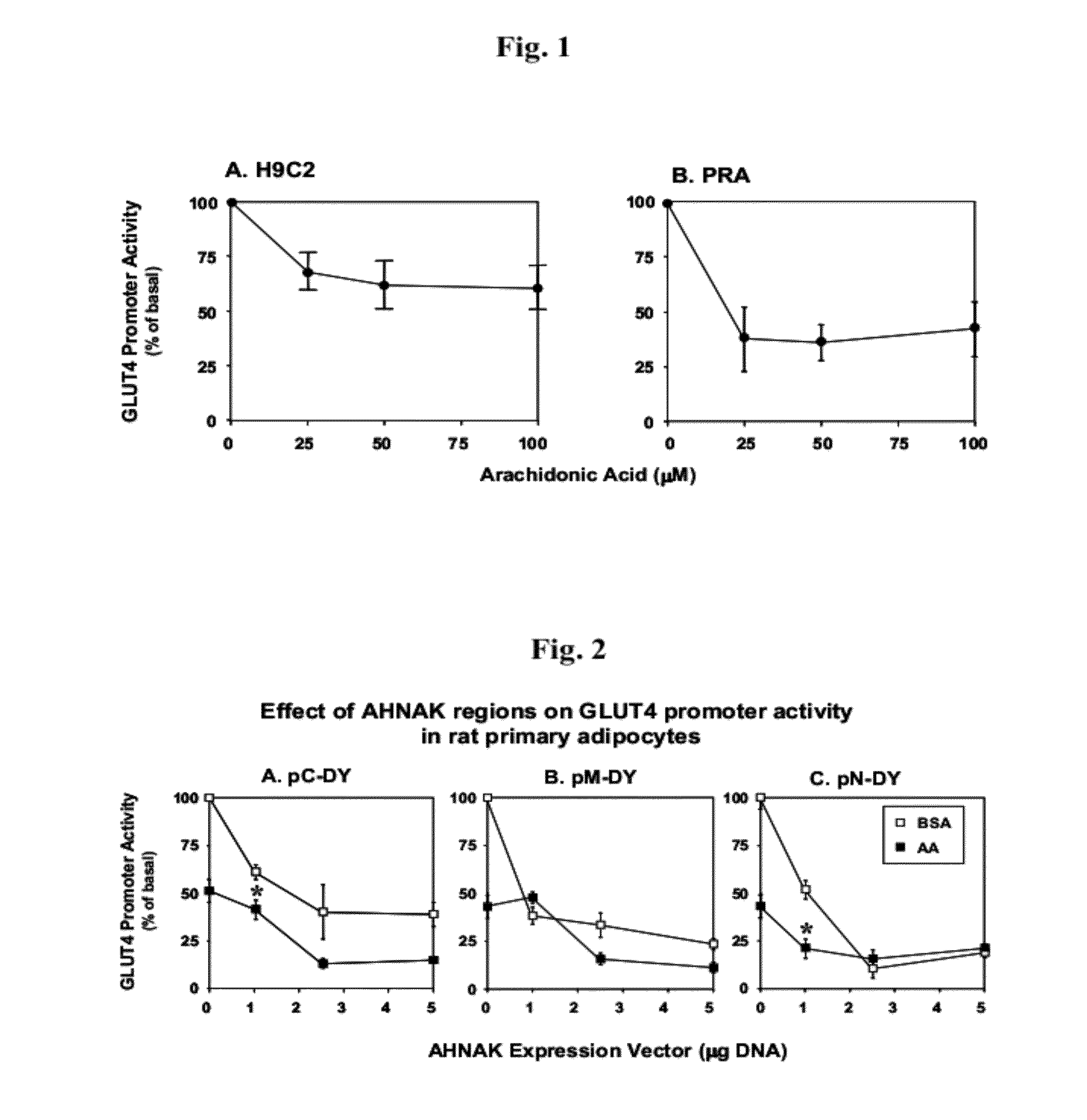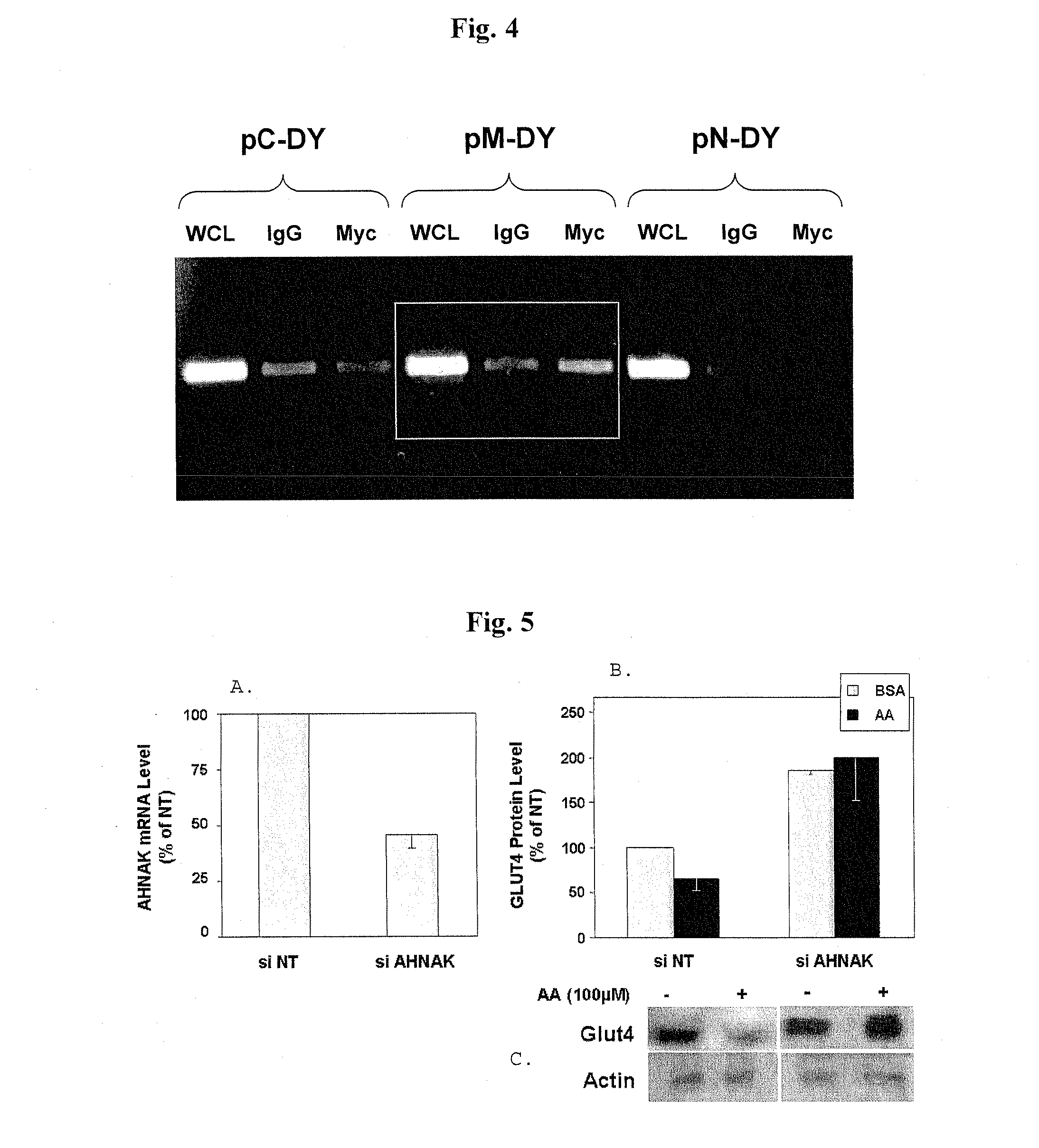Modulation of glut4 gene promoter activity by ahnak
a technology of ahnak and promoter activity, applied in the field of ahnakmediated glut4 gene promoter repression, can solve the problems of risk interference with protein synthesis, ffa may exert their detrimental effects, endogenous product(s) mediating this effect remain illusive, etc., and achieve the effect of reducing the ahnak phosphoprotein-mediated repression of glut4 gene expression
- Summary
- Abstract
- Description
- Claims
- Application Information
AI Technical Summary
Benefits of technology
Problems solved by technology
Method used
Image
Examples
example 1
Isolation of AHNAK Protein Attached to GLUT4 Promoter Sequence −222 / −197 bp
[0066]In a previous work, we identified the −212 / −197 by region of GLUT4-P as mediator of arachidonic acid repression of GLUT4-P (Armoni et al., 2005). Presently, we used a 5′-biotinylated 25-mer corresponding to the −212 / −197 by sequence of GLUT4-P, conjugated to biotin-avidin affinity column, as a bate to identify potential DNA binding protein(s) from nuclear extracts prepared from arachidonic acid-treated H9C2 cells. Mass spectrometry analysis of the eluates revealed 9 peptides resembling the AHNAK / Desmoyokin nucleoprotein, that were attached to the 25-mer bate (data not shown). As AHNAK was previously shown to participate in arachidonic acid-mediated cellular signaling in cardiac muscle (Sekiya et al, 1999; Sussman et al., 2001), we hypothesized that it can also be the protein mediating arachidonic acid-induced GLUT4-P repression. Furthermore, our data show that the area located within −212 / −197, which we...
example 2
Arachidonic Acid and AHNAK Repress GLUT4 Promoter Activity
[0067]To establish PRA as a suitable cellular model for arachidonic acid studies, parallel experiments were preformed in H9C2 and in PRA. Both cell types were transfected with GLUT4-P reporter, and incubated with ambient arachidonic acid levels as indicated. Our data show that in both cell types, arachidonic acid dose-dependently repressed transcription from GLUT4-P (FIGS. 1A-B), with major effect observed in PRA (FIG. 1B).
[0068]AHNAK (“giant” in Hebrew) is the biggest protein ever cloned, notable for its exceptional size of ˜700 kDa (Shtivelman et al., 1992). To investigate which domain(s) of AHNAK protein are responsible for its binding to, and regulation of GLUT4-P expression, we used three different eukaryotic expression plasmids, pC-DY, pM-DY, and pN-DY, which were previously shown to express C-terminus, middle domain, and N-terminus of this molecule, respectively, upon transfection to cells (Hashimoto et al., 1993; Nie ...
example 3
Detection of cis-Elements on GLUT-P That Mediate its Repression by AHNAK
[0069]To identify cis-elements on the GLUT4 promoter, that may serve as potential AHNAK binding sites, we performed a progressive 5′-deletion analysis of the full-length GLUT4-P reporter. Cells were transfected with a series of 5′-deleted promoter reporters (FIG. 3A), along with either pC-DY, pM-DY, or pN-DY of AHNAK (FIG. 3B). As a reference for maximal GLUT4-P activity, cells were transfected with GLUT4-promoters but not with an AHNAK expression vector. We found that deleting GLUT4-P area located within −1110 / −675 was sufficient to mediate AHNAK C terminal maximal repression of the GLUT4-P. AFINAK middle part maximal repression requires deleting two adjacent areas in GLUT4-P; an area located within −1110 / −675 as well as −675 / −488. Only when the two areas are deleted. AHNAK middle part was able to induce further repression of GLUT-4 promoter.
[0070]Since our findings in this work confirmed that AHNAK mediates FF...
PUM
| Property | Measurement | Unit |
|---|---|---|
| width | aaaaa | aaaaa |
| resistance | aaaaa | aaaaa |
| insulin resistance | aaaaa | aaaaa |
Abstract
Description
Claims
Application Information
 Login to View More
Login to View More - Generate Ideas
- Intellectual Property
- Life Sciences
- Materials
- Tech Scout
- Unparalleled Data Quality
- Higher Quality Content
- 60% Fewer Hallucinations
Browse by: Latest US Patents, China's latest patents, Technical Efficacy Thesaurus, Application Domain, Technology Topic, Popular Technical Reports.
© 2025 PatSnap. All rights reserved.Legal|Privacy policy|Modern Slavery Act Transparency Statement|Sitemap|About US| Contact US: help@patsnap.com



